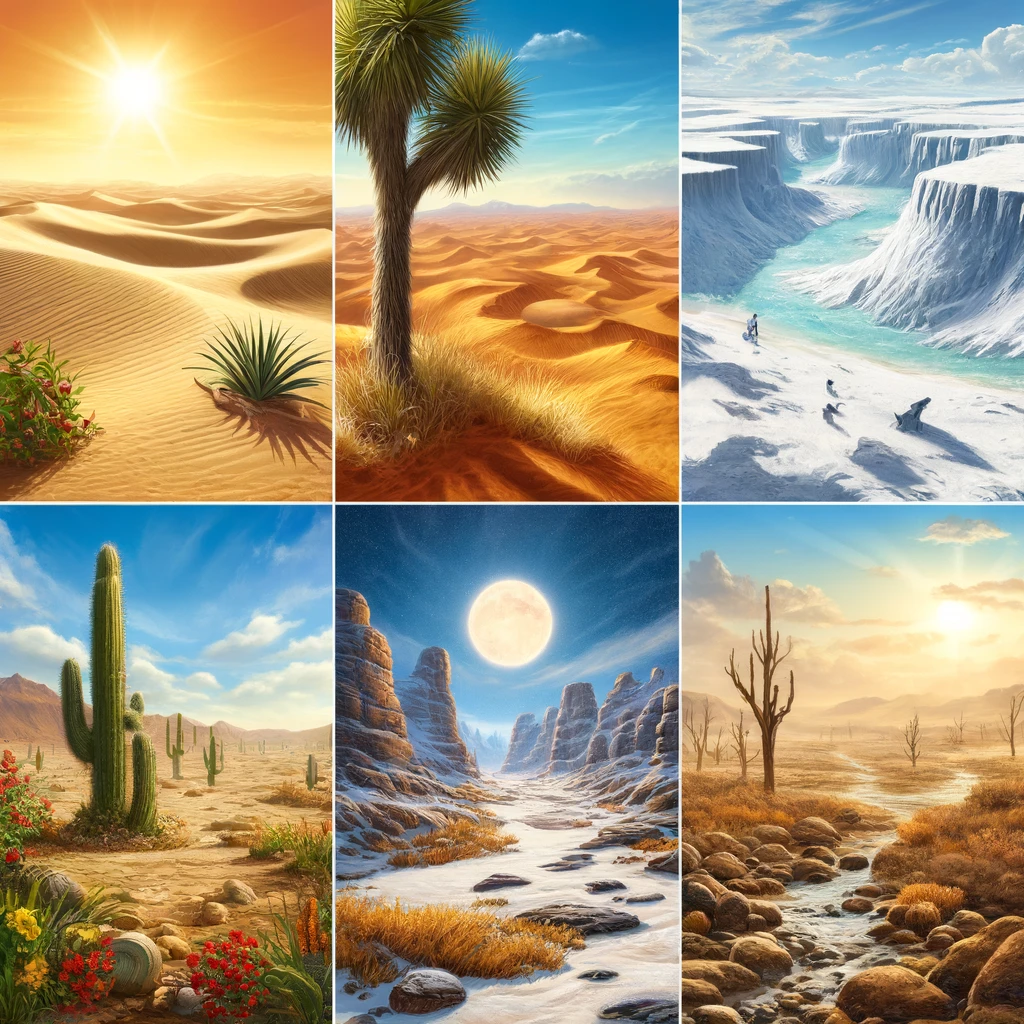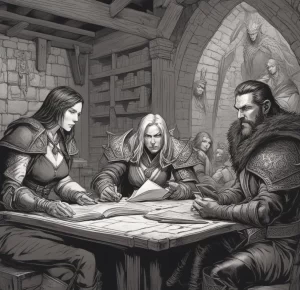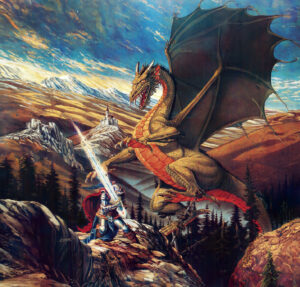
Desert
Not all deserts are covered with sand, and not all of them are in hot climates, but every desert has one thing in common with all the others: They are very, very dry. The technical definition of a desert is any area that receives less than 10 inches of rain per year; in actuality, the yearly rainfall in most deserts might be half of that amount or even less. The lack of moisture in a desert does not render the area totally barren or uninhabitable.
Many plants and animals are naturally able to cope with a severe shortage of water; the cactus and the camel are perhaps the best-known examples. However, characters are not so fortunate; they need water frequently and in fairly large amounts, and the best way to satisfy this need during a trek across the desert is to carry a supply of drinking water (or the means to produce water magically). Although it is possible to find water in the desert, either by stumbling across an oasis or by digging for ground water, neither of these methods is especially reliable. Most deserts are composed of dry, hard-packed earth beneath a layer of gravel, with the terrain occasionally broken by a clump of large boulders.
Water can be particularly difficult to find in this kind of desert terrain, because the rainfall tends to run off the surface (flowing toward a place of lower elevation) instead of soaking into the ground. Relatively few deserts are covered with sand, which does permit water to soak into the terrain from where it can be recovered later. The icy wastes of the polar regions can also be considered deserts. In a desolate place such as the arctic north, vegetation and animal life are even more scarce than in a desert located in a hot climate.
Although moisture is abundant on the ground (in the form of ice), the terrain still qualifies as desert because it receives very little precipitation. On a sandy desert, dunes are formed by the action of the wind; their shape and size depend upon the amount of sand and the velocity of the wind that moves it around. Where sand is abundant and the wind is at least occasionally very strong, dunes can grow to be more than 500 feet high. The slope gradually ascends in the direction of the wind. From the peak of the dune, the sand slopes down sharply on the side opposite the wind direction. In a very active wind, the peak of a dune can move several hundred feet in only a day or two; as windblown sand cascades down the slope away from the wind, that side of the dune becomes able to support more and more sand, and eventually the dune peaks at a point farther downwind.
Where the supply of sand is smaller and the wind is less intense, dunes are correspondingly smaller and shorter. In fact, the technical definition of "dune" is an accumulation of sand, formed by wind action, that is no more than 70 feet high. Anything larger is properly called a sand mountain, or "draa." An object (or a character) that remains in one spot for any great length of time in a desert with heavy sand cover may end up buried under tons of sand. On the other hand, the action of the shifting sands may uncover the entrance to the hidden temple that you've been searching for. . . .
Forest
The term "forest" covers a lot of ground, literally and figuratively. In the typical campaign world, unspoiled by industrial revolutions and large-scale lumbering operations, expanses of densely packed trees can be found in any climate except the polar regions, where the eternal cold makes it impossible for trees and other large plants to survive. Forests in different climatic areas contain different kinds of trees: evergreens, or conifers, in the subarctic; deciduous, or leaf-bearing, in temperate regions; and "evergreens" of an entirely different sort in subtropical and tropical areas.
Characters may discover a large stand of tall cactus in the middle of a desert, but this feature does not qualify as a forest in game terms; the area is still considered as desert for purposes of weather determination, availability of food and water, and so forth. Taiga (a Russian word) is the name often used to refer to the band of forest that exists on Earth, forming a rough circle just south of the Arctic Circle. The northern edge of the taiga is the "tree line," north of which the climate will not support large plant life. The conifers get their name from their distinctive shape - a tall, thin cone that enables them to shed snow easily. Their branches are tightly packed with twigs, and the twigs are covered with needles - leaves that are very narrow and have a very small surface area, so that the tree loses very little water through evaporation. (Conifers don't need as much water as other trees, but they have to be careful to conserve what they do receive.) Conifer branches are a good source of material for an impromptu shelter because their "leaves" are so densely packed.
Where water is relatively more abundant (near rivers and lakes, and on the southern edge of the taiga), some broadleaf trees may be located. They blossom only briefly during the short subarctic summer, but are able to prosper year after year because of the availability of water. Temperate forests contain a wide variety of trees, all of which have one important common feature: They are very adaptable, able to withstand the scorching heat of a temperate summer as well as the vicious deep-freeze of a temperate winter.
Most temperate forests are composed primarily of deciduous trees - the kind that shed their leaves when cold weather approaches, stand with branches bared to the winter wind, and then grow new leaves when the cold season is over. A temperate forest is a lush breeding ground for many types of smaller plants because the "crop" of fallen leaves each autumn keeps the soil rich in nutrients. However, there are fewer ground plants and less underbrush in a temperate forest than in a rainforest, for the reasons explained in the following paragraph. The largest trees in a temperate forest (usually oak, maple, and ash) can be as much as 160 feet tall with a "leafspan" nearly as great as that. Rainforest is the name usually given to forests in subtropical and tropical climates. The distinctive feature of a rainforest is its ''layered'' composition; trees of several different heights coexist with low-lying shrubs and ferns.
Most of the trees in a rainforest have thin, straight trunks that stretch toward the sky and are topped (in the fashion of an ice-cream cone or a mushroom) by a roughly egg-shaped clump of vegetation. The trees do not spread out close to the ground the way that trees in a temperate forest do, which makes it possible for a rainforest to support a thick layer of low-lying vegetation at ground level. On a sunny day, a lot of light reaches the floor of a rainforest; on the same kind of day in a temperate forest, many areas beneath wide, tall trees remain shaded from dawn to dusk. As one might expect from its name, a rainforest is also covered with vegetation because of the large amount of precipitation the area receives. Trees in a rainforest are green all year round; before old leaves grow large and drop off, new ones have already appeared to take their places.
Hills
This type of terrain has much more to do with topography than with ecology. A forest can be hilly, as can a desert (even a sandy desert, if you consider the dunes to be hills). Hills can be gently rolling mounds or craggy, mountainlike piles of rock and earth that jut out of the surrounding landscape. For purposes of classifying a certain area that includes hilly terrain, the Dungeon Master or Game Master can use the following guidelines: Any irregular (not level) terrain that includes dense or moderate tree cover is forest. An area of gently rolling hills at an elevation of less than 2,000 feet containing few or no trees is classified as some type of terrain other than hills; use whichever designation (desert, plains, swamp, or seacoast) is appropriate. An area is classified as hills if it is generally at an elevation of less than 2,000 feet, contains few or no trees, and has sharply sloping mounds with peaks that may rise above 2,000 feet. Or, an area is classified as hills if it is at an elevation of between 2,000 and 4,000 feet, generally contains irregular terrain. and has few or no trees.
Mountains
For game purposes, mountainous terrain is devoid of large vegetation and usually occurs at high elevation (4,000 feet or above). A heavily wooded area on the lower slopes of a mountain should be considered as forest, even if the elevation is higher than 4,000 feet. A mountainous region (for determination of movement, encounters, food availability, etc.) begins where the trees end. On Earth, the "tree line" (at about 10,000 feet above sea level) marks the place where deciduous growth gives way to coniferous trees, which are better suited for survival at higher elevations and colder temperatures. Beyond the "snow line" (12,000 feet), trees cannot prosper, and only low-lying plants and shrubs can be found; if characters have not reached mountainous terrain by the time they've climbed this high, they will certainly be in mountains if they go any higher.
A barren, rocky slope that begins at relatively low elevation and rises high above the surrounding area can also be considered as mountainous terrain, even if the base of the slope is lower than 4,000 feet above sea level. If hills can be described as irregular terrain, then mountains are downright chaotic. If there is a level spot to be found on a mountainside, it will probably be surrounded on all sides by severe slopes and vertical or near-vertical cliff faces. Of course, the lower slopes of a mountain are much less treacherous than the area near the peak - but, as noted above, the lower slopes often contain features (usually trees) that require the area to be classified as something other than mountainous.
At any elevation higher than the snow line, some of the rocky surface of a mountain will be covered with snow or ice, making travel even more hazardous. In contrast, exposed rock surfaces at high altitudes can become much warmer than the air temperature because they absorb heat from the sun throughout the day -and on a mountain, there is no such thing as shade except on a slope opposite the sun or in the area beneath an overhang. A mountain is a study in contrasts - warm in some places, cold in others; practically impossible to climb in some spots, fairly easy to negotiate in others; a place of safety or a place of danger, depending on your point of view and how well equipped you are to deal with the terrain. Not all mountainous areas are inherently treacherous, but adventurers who ascend into the peaks without proper planning and preparation are either very desperate or very foolish.
Plains
The name itself implies something unexciting, even boring. But, in the words of the original bard, What's in a name? The plains of Africa and South America, known as savannas, support perhaps the greatest diversity of wildlife of any place on Earth. The great plain of central North America, before it was "domesticated," was also teeming with wildlife - and, of course, with the vegetation that the wildlife needed to survive.
This terrain designation takes in many types of flat areas, most of which (except in an arctic climate) have at least a moderately dense cover of low-lying vegetation - grasses and small shrubs that have remarkable regenerative powers even after they are eaten almost down to ground level by hungry animals. An occasional tree or small grove of trees also dots the landscape - not enough trees to qualify as a forest, but enough to provide protection from a herd of stampeding elephants.
The monotony of the level terrain may be periodically broken by rolling hills or bluffs, but again these features are not frequent enough or predominant enough to cause a change in classification. Food and water are generally easy to find on a plain, but the materials for an impromptu shelter (tree branches, logs, etc.) are not so easily come by. Because the terrain is usually flat and featureless, adventurers should be especially careful to keep their eyes and ears open: Whenever they can see for a long distance, they should realize that they, in turn, can be seen from far away.
Seacoast Simply put, practically any place that is a short distance from an ocean is seacoast terrain. In these rules, the distinction is important for determining weather conditions, the availability of animals (for food) and the availability of plant life (for both food and medicinal purposes).
Swamp
In game terms, a swamp is any place where a character's feet hit standing water shortly before hitting the ground. Swamps are always located at low elevation or on flat or slightly depressed land at the edge of a river or lake. The vegetation may resemble that of a grassy plain, or it may be forest like, but no matter what shape and size it comes in, there is always a lot of it; the soil in swampy areas is extremely fertile because it contains a great quantity of decomposed vegetable matter - and, of course, no plant in a swamp ever has to go very far for water.
The depth of the standing water in a swamp can vary from practically zero (where the ground is merely spongy) to several feet, and sometimes goes from shallow to deep in the space of just a few steps if the underlying terrain is irregular. Movement through a swamp can be very difficult, if not actually dangerous, and a swamp is not a good place to take mounts or pack animals. If the shortest distance between two points would take characters on a path through a swamp, they would be well advised to circumvent the soggy area and spend a few more steps to get where they're going. But if their destination is inside the swamp. . . well, even if the adventure isn't wild, it will certainly be wet.
Hierarchy of Terrain
The preceding text gives some advice on how to deal with terrain that seems to belong in two categories at once. Even with that advice in mind, occasions may arise when there is some question in the Dungeon Master's or Game Master's mind about how an area of terrain should be classified. If that happens, the following ranking may be of use:
1. Seacoast
2. Swamp
3. Forest
4. Plains
5. Desert
6. Hills
7. Mountains
If an area has properties that are particular to two or more terrain categories, consider it as terrain of the highest-ranking category (1 being the highest rank, 7 being lowest). For instance, a sandy beach that borders the ocean is considered seacoast, not desert.
A low-lying area with standing water and a lot of large trees is swamp, not forest. Obviously, certain circumstances will not fit this ranking system. If the waves of an ocean crash against the base of a jagged, rocky slope, the area next to the sea is mountains, not seacoast. If a deep valley between two hills happens to contain a marshy area, the predominant terrain in the area is hills, not swamp. The listing above should only be used when common sense and reasonability do not help the Dungeon Master and Game Master reach a decision.
Bodies of Water
In a typical campaign world, rivers and lakes serve at least two important purposes: They provide a ready source of water, and their presence requires a party of adventurers to be more versatile. A body of water is both an opportunity and a challenge. Travel on the surface of a lake or river is often faster, easier, and safer than negotiating the surrounding terrain on foot - but only if characters have access to a boat or a barge and someone in the group has the skill to handle the craft expertly.
Swimming across a deep, wide river, instead of following the shoreline and looking for a place to ford, can save hours or even days of travel time - but only if characters have the ability to swim in the first place. To be fully prepared for a trek through the wilderness, a party of adventurers should have equipment and skills for coping with bodies of water as well as for moving on land.






